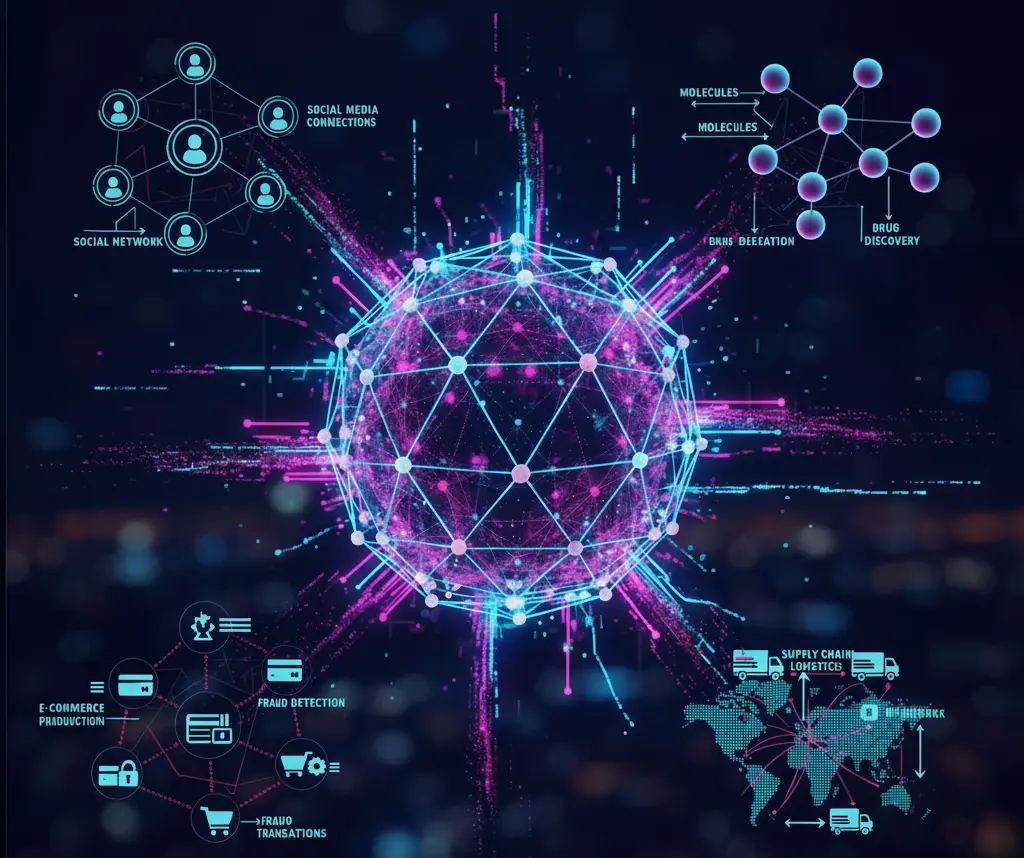Graph Neural Networks (GNNs) in Real Life
In today’s digital world, data rarely exists in isolation. Whether it is people interacting on social media, financial transactions connecting banks, or atoms forming molecules, everything is linked. These relationships form complex networks, also known as graphs.
To make sense of these interconnected systems, researchers and businesses are turning to Graph Neural Networks (GNNs), a breakthrough in artificial intelligence that learns not only from data points but also from the connections between them.
What GNNs Are and How They Work
A Graph Neural Network (GNN) is a type of neural network designed specifically for graph-structured data, which includes nodes (entities) and edges (relationships).
Traditional machine learning models treat each piece of data independently, but GNNs look deeper. They understand how each entity is related to others and use that information to make more intelligent predictions. Here is how it works in simple terms:
- Each node represents an entity — such as a user, product, or atom.
- Each edge represents a connection or interaction — like a friendship, purchase, or chemical bond.
- The GNN passes messages between connected nodes so that each node can learn from its neighbors and the wider network.
For example, in a social media graph, a GNN does not just analyze a single user’s activity. It also learns from their friends’ behaviors, shared interests, and group patterns giving a much deeper understanding than traditional algorithms.
This process, known as message passing, is what enables GNNs to discover complex relationships and hidden patterns.
Why Many Datasets Are Naturally Graphs (Social Networks, Molecules)
Graphs appear naturally in many aspects of modern life. Here are a few common examples:
- Social Networks: Users are nodes, and their friendships or follows are edges. Platforms like Facebook or LinkedIn use these structures to detect communities, suggest connections, or recommend content.
- E-Commerce and Recommendations: Products, customers, and transactions form graphs that can reveal relationships and buying patterns.
- Molecular Structures: In chemistry and drug discovery, atoms (nodes) and bonds (edges) form molecular graphs. Analyzing these with GNNs helps predict chemical properties.
- Finance: Accounts, transactions, and merchants create graphs that can expose hidden fraud networks.
- Transport and Logistics: Routes, warehouses, and delivery points form interconnected graphs that can be optimized for efficiency.
These examples show that much of the world’s data is inherently graph-based, making GNNs one of the most naturally aligned AI technologies for modern analytics.
Applications: Fraud Detection, Drug Discovery, Recommendation System
GNNs have found applications in a variety of industries because they excel at uncovering relationships within large, connected datasets
1. Fraud Detection
Financial institutions use GNNs to analyze complex networks of transactions. By mapping accounts, payments, and devices, GNNs can identify suspicious patterns such as hidden connections between fraudulent accounts that rule-based systems might miss.
2. Drug Discovery
In healthcare and pharmaceuticals, GNNs represent molecules as graphs. Each atom is a node and each bond is an edge. By learning the chemical structure, GNNs can predict molecular properties and interactions, helping researchers discover new drugs faster and at lower cost.
3. Recommendation Systems
GNNs power next-generation recommendation engines by analyzing user-product relationships. For example, if several customers who purchased one product also bought another, the GNN identifies this link and makes smarter, more personalized recommendations.
4. Cybersecurity
In network monitoring, GNNs detect malicious connections between devices or servers by examining the entire communication graph. This helps security teams prevent attacks before they happen.
5. Supply Chain Optimization
By modeling suppliers, distributors, and delivery routes as a graph, GNNs can predict bottlenecks, improve demand forecasting, and ensure smoother supply chain operations.
Future Trends in GNN Research
The research community and industry leaders are continuing to improve GNNs, making them more efficient, interpretable, and scalable. Some of the key trends include:
- Scalability and Efficiency: Handling graphs with billions of nodes (like social networks) requires optimized algorithms and distributed computing.
- Explainable GNNs: As AI becomes part of critical systems, understanding why a GNN makes a prediction is essential. Researchers are working on models that are both powerful and transparent.
- Dynamic Graphs: Many real-world graphs change over time such as friendships forming or markets evolving. Dynamic GNNs are being developed to adapt continuously to new data.
- Hybrid AI Systems: Combining GNNs with natural language processing (NLP) or computer vision allows systems to learn from multiple data types simultaneously.
Edge AI and IoT Integration: Lightweight GNNs are being optimized to run on devices with limited computing power, enabling smart IoT systems that can reason about network data locally.
Example Implementation Idea
To understand GNNs better, consider this practical scenario.
Scenario: A retail company wants to recommend new products to its customers.
- Nodes: Customers and products.
- Edges: Past purchases, views, or interactions.
- Goal: Predict which product a customer is most likely to buy next.
A GNN can process this network and find hidden patterns. For example, even if two customers have not bought the same product, their connections through shared interests or similar purchasing patterns help the model recommend products more accurately.
Similarly, in fraud detection, a GNN could detect that several bank accounts are indirectly linked through shared devices or suspicious transaction paths, something a traditional model might overlook.
Conclusion
Graph Neural Networks are reshaping how we understand and analyze complex data. Instead of treating information as isolated records, GNNs focus on relationships enabling smarter predictions, deeper insights, and more connected intelligence.
From fraud detection and drug discovery to recommendation systems and supply chain management, GNNs are already making a significant impact in real-world applications.
As research continues and technology becomes more accessible, GNNs will play a key role in the next wave of AI innovation, one where understanding connections becomes just as important as understanding data itself.









